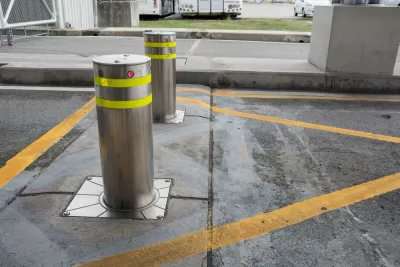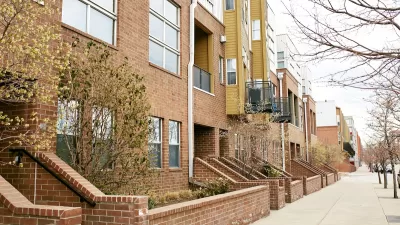Roadway designs protect drivers and construction workers with robust barriers. Why don't we protect pedestrians in the same way?

Assessing the different types of barriers installed on American roadways, Charles Marohn argues that we need beefed-up protection for pedestrians, much like we provide for drivers or construction workers. At roadway construction sites, Marohn writes, "[t]he concrete barriers do not have a breakaway design. There are no shear pins to absorb the kinetic energy of an errant vehicle. A driver who loses control in a construction zone is going to feel the brutal consequences of that mistake. The construction worker will not."
Marohn asks, "[w]hy are we concerned with the construction worker and not the kid walking the sidewalk? Why are we concerned with the oncoming traffic and not the person waiting at the traffic signal?" Historically, roadway designs have ensured protection for drivers while ignoring people on the sidewalk who might get struck by out-of-control cars.
"America needs a billion bollards. There is no coherent argument against lining every street in America with them. This is the minimum level of protection needed to keep people safe from violence. It is the least we can do to correct the massive asymmetry of risk experienced on our nation’s streets by people outside of a vehicle."
To improve transportation, Marohn asserts, "skip the megaprojects." Not doing more to protect pedestrians amounts to "institutionalized gross negligence."
FULL STORY: One Billion Bollards

Alabama: Trump Terminates Settlements for Black Communities Harmed By Raw Sewage
Trump deemed the landmark civil rights agreement “illegal DEI and environmental justice policy.”

Planetizen Federal Action Tracker
A weekly monitor of how Trump’s orders and actions are impacting planners and planning in America.

Why Should We Subsidize Public Transportation?
Many public transit agencies face financial stress due to rising costs, declining fare revenue, and declining subsidies. Transit advocates must provide a strong business case for increasing public transit funding.

Understanding Road Diets
An explainer from Momentum highlights the advantages of reducing vehicle lanes in favor of more bike, transit, and pedestrian infrastructure.

New California Law Regulates Warehouse Pollution
A new law tightens building and emissions regulations for large distribution warehouses to mitigate air pollution and traffic in surrounding communities.

Phoenix Announces Opening Date for Light Rail Extension
The South Central extension will connect South Phoenix to downtown and other major hubs starting on June 7.
Urban Design for Planners 1: Software Tools
This six-course series explores essential urban design concepts using open source software and equips planners with the tools they need to participate fully in the urban design process.
Planning for Universal Design
Learn the tools for implementing Universal Design in planning regulations.
Caltrans
Smith Gee Studio
Institute for Housing and Urban Development Studies (IHS)
City of Grandview
Harvard GSD Executive Education
Toledo-Lucas County Plan Commissions
Salt Lake City
NYU Wagner Graduate School of Public Service





























